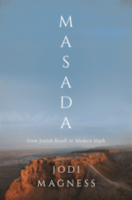
Princeton (2019) h/b 288pp £24 (ISBN 9780691167107)
The rock of Masada beside the Dead Sea, stunningly illustrated on the dustjacket of this book, is the second most popular tourist site in Israel, where many remains of people, artefacts and documents have been well-preserved by the arid desert conditions. The site is inextricably linked with Josephus’ dramatic story about the suicide pact of the Jewish defenders that ended the Roman siege of 73-4CE. But did this famous episode really take place?
The question acts as the focus for a broader presentation of the history of Judea from the mid-second century BC to the first century AD by M., who led many site tours from 1977 to 1980, and in 1995 co-directed excavations at the Roman siege works encircling the raised outcrop. Nevertheless the study is highly accessible to a non-specialist audience as it is clearly written and all technical terms are simply explained.
After an initial scene-setting prologue, the appealing narrative launches itself in time-honoured fashion in medias res, with an account of the Roman siege that took place three years after the fall of Jerusalem in AD 70. M. points out the importance of the site of Masada to specialists of Roman siege works and camps owing to the excellent state of preservation of these stone buildings in their remote desert location.
Subsequent chapters expand on the background of the site and the country of Judea. The author narrates the history of Masada: its 19th c. rediscovery by western explorers and surveyors of topographical maps, as well as its post-1948 significance as a site for youth group camping expeditions. There is an exposition of the natural setting and wildlife of the wider area including the Dead Sea, along with its historical origins and earliest settlement and a description of Herod the Great’s fortifications and two palaces at Masada, detailing the interior luxury of the buildings as well as its gardens, cisterns, aqueducts, pools and bath houses, and a brief survey of his building works in Jerusalem, the artificial harbour and constructions of Caesarea Maritima, and the Herodium, his tomb and memorial.
Next M. explains the history of Judea before Herod: the rebellion of the Maccabees, ancient Jewish sectarianism and the evidence of the Dead Sea Scrolls, the Hasmonean kings and the civil wars leading to the intervention of Rome. Chapter 6 narrates the troubled history of the country after Herod’s death in the time of the Roman procurators and Herod Agrippa, with riots and unrest provoked by terrorists known as sicarii and the appearance of several Messianic figures. There is a description of the First Jewish revolt against Rome in AD 66-70; of the siege and fall of Jerusalem, the destruction of the Temple, the Flavian triumph in Rome and the effective measures taken for the obliteration of the Jewish religion and national homeland.
Chapter 8 presents the archaeological evidence for the Jewish occupation of Masada from D 66-73/4 in housing, food, religious installations, clothing and administration, and the final chapter brings the historical record up to date with an account of the 1963-5 excavations and publication of the influential popular work by Yigael Yadin, as well as tracing the creation of the modern Masada myth: how a motley collection of Jewish refugees dominated by a group of terrorists turned into a band of Jewish freedom fighters at the birth of the modern nation of Israel. Although the symbolism of the site may since have declined for Israel itself since the country’s movement into free market capitalism, yet M. emphasises Masada’s enduring appeal to this day as a place of pilgrimage for Diaspora Jews (p. 200). The short epilogue contains a recommended itinerary for touring the site and the work also contains extensive notes and bibliography to facilitate further investigation. Many photographs enliven the text including some spectacular colour aerial views of the mountain fortresses, as well as numerous black and white illustrations and two maps.
M. lucidly explains her reasons for doubting the essential truth of Josephus’ story about the controversial suicide pact: that his is the only account of these events, which he might have written up as a gripping literary device to end his history of The Jewish War, of his likely pro-Roman bias through being commissioned to write by the Flavian victors, eager to encourage a portrayal of the bravery of the Jewish rebels to elevate the magnitude of the Roman victory, and of an equivalent bias permeating the modern publication of Yigael Yadin, keen to present his academic fieldwork with a Zionist slant in an effort to counter the image of the passive deaths of Jews in Nazi concentration camps during World War II.
It is a little anticlimactic to have M. so tamely abandoning the resolution of her narrative’s main thrust to Josephus specialists (p. 196), merely pointing out that the archaeological record can support different interpretations. But this does not diminish the strength of the book in bringing to life the archaeological remains of the site, such as the slum dwellings hastily thrown up within the great rooms of Herod’s palaces; the labelled storage jars of grain and legumes infested with pests; or the strands of women’s hair still clinging to their woollen hairnets (p. 184). Nor does it detract from its fascination as a notable lesson in the inventiveness of even reputable field archaeologists in distorting their interpretation of archaeological and historical facts to fit their personal agendas.
It is also a very good case study of the way in which archaeology can be used as a means of bolstering a country’s national pride through the remains of its history. This book tells us as much about the creation of modern Israel as about ancient Jewish history, and about how the site of Masada still remains a potent symbol in the eyes of the world as a ‘modern passion play of national rebirth’ (p. 200).
Claire Gruzelier
